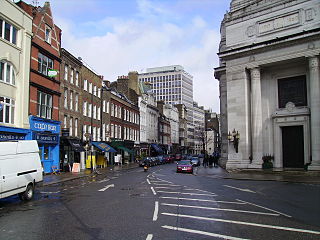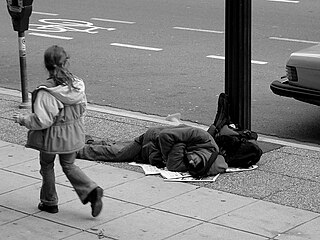
A public space is a place that is open and accessible to the general public. Roads, pavements, public squares, parks, and beaches are typically considered public space. To a limited extent, government buildings which are open to the public, such as public libraries, are public spaces, although they tend to have restricted areas and greater limits upon use. Although not considered public space, privately owned buildings or property visible from sidewalks and public thoroughfares may affect the public visual landscape, for example, by outdoor advertising. Recently, the concept of shared space has been advanced to enhance the experience of pedestrians in public space jointly used by automobiles and other vehicles.

Street furniture is a collective term for objects and pieces of equipment installed along streets and roads for various purposes. It includes benches, traffic barriers, bollards, post boxes, phone boxes, streetlamps, traffic lights, traffic signs, bus stops, tram stops, taxi stands, public lavatories, fountains, watering troughs, memorials, public sculptures, and waste receptacles.

High Holborn is a street in Holborn and Farringdon Without, Central London, which forms a part of the A40 route from London to Fishguard. It starts in the west at the eastern end of St Giles High Street and runs past the Kingsway and Southampton Row, becoming Holborn at its eastern junction with Gray's Inn Road. The western stretch, as far as Drury Lane, was formerly known as Broad Street. On High Holborn, traffic flows one-way westbound from its junction with Drake Street to its western end, and flows both ways for the remainder.

Great Queen Street is a street in the West End of central London in England. It is a continuation of Long Acre from Drury Lane to Kingsway. It runs from 1 to 44 along the north side, east to west, and 45 to about 80 along the south side, west to east. The street straddles and connects the Covent Garden and Holborn districts and is in the London Borough of Camden. It is numbered B402.

In skateboarding, grinds are tricks that involve the skateboarder sliding along a surface, making contact with the trucks of the skateboard. Grinds can be performed on any object narrow enough to fit between wheels and are performed on curbs, rails, the coping of a skate ramp, funboxes, ledges, and a variety of other surfaces.
A skateboard style refers to the way a skateboarder can ride a skateboard. Styles of skateboarding have evolved and are influenced by a number of factors including sociocultural evolution, mass media, music, technology, and corporate influence.

Homelessness, also known as houselessness or being unhoused or unsheltered, is the condition of lacking stable, safe, and functional housing. It includes living on the streets, moving between temporary accommodation with family or friends, living in boarding houses with no security of tenure, and people who leave their homes because of civil conflict and are refugees within their country.

Discrimination against homeless people is categorized as the act of treating people who lack housing in a prejudiced or negative manner because they are homeless. Other factors can compound discrimination against homeless people including discrimination on the basis of race, gender, sexuality, age, mental illness, and other considerations.

Anti-homelessness legislation can take two forms: legislation that aims to help and re-house homeless people; and legislation that is intended to send homeless people to homeless shelters compulsorily, or to criminalize homelessness and begging.
In the United States, a sit-lie ordinance is a municipal ordinance which prohibits sitting or lying on the sidewalk or in other public spaces.

Street skateboarding is a skateboarding discipline which focuses on flat-ground tricks, grinds, slides and aerials within urban environments, and public spaces. Street skateboarders meet, skate, and hang out in and around urban areas referred to as "spots," which are commonly streets, plazas or industrial areas. To add variety and complexity to street skateboarding, obstacles such as handrails, stairs, walls, flower beds, bins, park benches, picnic tables, and other street furniture may be traversed as single tricks or as part of a series of consecutive tricks called a "line."

Skatestoppers are skate-deterrent or anti-skate devices placed on urban terrain features, such as benches and handrails, to discourage skateboarders from grinding on the surfaces where they have been installed. They are a form of hostile architecture.

Tactical urbanism, also commonly referred to as guerrilla urbanism, pop-up urbanism, city repair, D.I.Y. urbanism, planning-by-doing, urban acupuncture, and urban prototyping, is a low-cost, temporary change to the built environment, usually in cities, intended to improve local neighbourhoods and city gathering places.

Hostile architecture is an urban-design strategy that uses elements of the built environment to purposefully guide behavior. It often targets people who use or rely on public space more than others, such as youth, poor people, and homeless people, by restricting the physical behaviours they can engage in.
A conscious city is a large built environment that is aware of the needs and activities of its inhabitants and responds to them. Research in conscious cities explores how architecture and urban design can better consider and respond to human needs through data analysis, artificial intelligence, and the application of cognitive sciences in design.

Homelessness in the United States has differing rates of prevalence by state. The total number of homeless people in the United States fluctuates and constantly changes, hence a comprehensive figure encompassing the entire nation is not issued, since counts from independent shelter providers and statistics managed by the United States Department of Housing and Urban Development vary greatly. Federal HUD counts hover annually at around 500,000 people. Point-in-time counts are also vague measures of homeless populations and are not a precise and definitive indicator for the total number of cases, which may differ in both directions up or down. The most recent figure for 2019, was 567,715 individuals nationally that experienced homelessness at a point in time during this period.
Spatiality is a term used in architecture for characteristics that, looked at from a certain aspect, define the quality of a space. In comparison to the term spaciousness, which includes formal, dimensional determination of size—depth, width or height—spatiality is a higher category term. It includes not only formal but other qualities of space—such as definition, openness, visibility, expressivity, etc.

A urine deflector is a device for deflecting the stream of urine during urination. These may be part of a chamber pot, latrine or toilet intended for the purpose, or they may be deterrents, installed in the sides or corners of buildings to discourage their casual use as urinals by passers-by. They may be constructed in various ways from a variety of materials but are typically designed to have an angled surface which catches and redirects the stream.

The Portsmouth Square pedestrian bridge is a prominent architectural landmark in Chinatown, San Francisco that spans over Kearny Street from Portsmouth Square to the second floor and third floor of the Hilton San Francisco Financial District hotel, which houses the Chinese Culture Center of San Francisco.
Secured by Design (SBD) is a police initiative in the UK that advises on the construction of buildings and development schemes to encourage the adoption of techniques or designs that are thought to discourage crime. SBD recommendations are included in the National Model Design Code and the programme incorporates training police officers as Designing Out Crime Officers (DOCOs), who are referred to in the National Planning Policy Framework, giving the initiative wide influence over British construction.
















